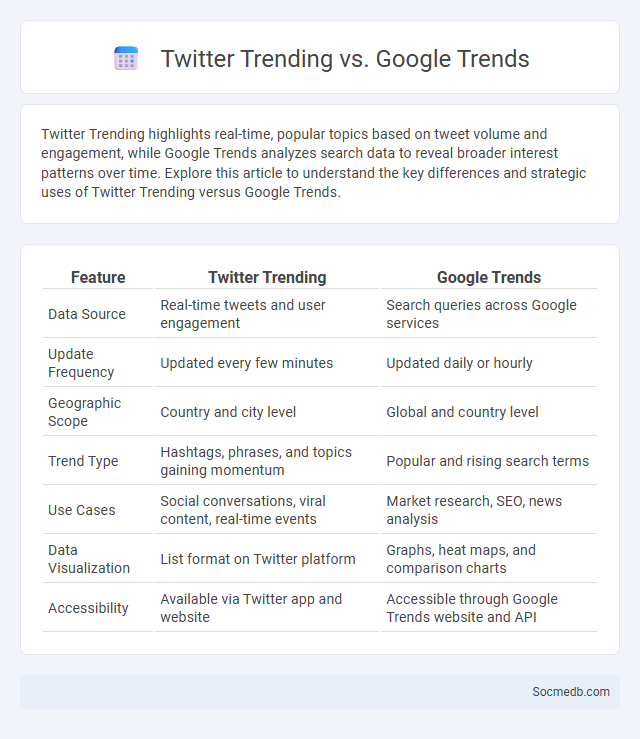
Photo illustration: Twitter Trending vs Google Trends
Twitter Trending highlights real-time, popular topics based on tweet volume and engagement, while Google Trends analyzes search data to reveal broader interest patterns over time. Explore this article to understand the key differences and strategic uses of Twitter Trending versus Google Trends.
Table of Comparison
| Feature | Twitter Trending | Google Trends |
|---|---|---|
| Data Source | Real-time tweets and user engagement | Search queries across Google services |
| Update Frequency | Updated every few minutes | Updated daily or hourly |
| Geographic Scope | Country and city level | Global and country level |
| Trend Type | Hashtags, phrases, and topics gaining momentum | Popular and rising search terms |
| Use Cases | Social conversations, viral content, real-time events | Market research, SEO, news analysis |
| Data Visualization | List format on Twitter platform | Graphs, heat maps, and comparison charts |
| Accessibility | Available via Twitter app and website | Accessible through Google Trends website and API |
Introduction to Trending Platforms
Trending social media platforms like TikTok, Instagram, and Snapchat dominate digital interaction by offering dynamic content formats such as short-form videos, Stories, and ephemeral messaging. These platforms leverage advanced algorithms to enhance user engagement through personalized content feeds and real-time social trends analysis. Understanding the unique features and audience demographics of these platforms is essential for maximizing reach and influence in digital marketing strategies.
What is Twitter Trending?
Twitter Trending refers to the real-time display of popular topics, hashtags, and conversations that are gaining rapid attention on Twitter within a specific region or globally. These trends highlight the most discussed subjects, events, or news stories, driven by user engagement and volume of tweets. The Twitter Trending algorithm uses factors such as tweet velocity, user location, and relevance to personalize and surface timely content for users.
How Does Google Trends Work?
Google Trends analyzes search data from billions of queries across different regions and languages to reveal the popularity of specific terms over time. It uses real-time and historical search volume data, normalizes this information, and generates insights such as interest by region, related queries, and trending topics. Social media marketers leverage Google Trends to identify emerging trends, gauge audience interests, and optimize content strategies for maximum engagement.
Understanding General Trending Topics
Analyzing social media platforms reveals trending topics by tracking hashtags, keywords, and engagement metrics in real-time. Algorithms on platforms like Twitter and Instagram aggregate user interactions to highlight popular discussions and viral content. Monitoring these trends provides insights into public interests, emerging issues, and cultural shifts across diverse demographics.
Key Differences: Twitter Trending vs Google Trends
Twitter Trending displays real-time popular topics based on user activity and hashtag usage within the social media platform, capturing immediate public interest. Google Trends analyzes search engine queries over time, offering insights into broader search behavior and seasonal interest patterns across various regions. Your understanding of current events can be enhanced by combining Twitter Trending's instant social sentiment with Google Trends' extensive search data analytics.
Real-Time Trends: Speed and Accuracy
Real-time trends on social media deliver instant insights into emerging topics, allowing you to engage with current conversations and maximize your content's relevance. Platforms use advanced algorithms and AI to monitor millions of posts simultaneously, ensuring speed and accuracy in trend detection. Harnessing these real-time analytics boosts your ability to respond proactively and maintain a competitive edge in dynamic digital environments.
Audience Demographics and Reach
Social media platforms attract diverse audience demographics, with age groups ranging from Gen Z to Baby Boomers, each exhibiting unique content preferences and engagement patterns. Facebook remains dominant among users aged 25-54, while Instagram and TikTok lead in popularity among younger audiences aged 18-34, providing brands targeted reach opportunities. Leveraging detailed audience insights and analytics tools enables marketers to optimize reach and tailor content strategies to enhance engagement and conversion rates effectively.
Data Sources and Analytical Tools
Social media data sources include platforms like Facebook, Twitter, Instagram, LinkedIn, and TikTok, providing vast amounts of user-generated content, engagement metrics, and behavioral data. Analytical tools such as Hootsuite, Sprout Social, Brandwatch, and Google Analytics enable comprehensive sentiment analysis, trend tracking, and audience insights by processing this data. Leveraging APIs and big data analytics helps businesses extract actionable intelligence from social media to enhance marketing strategies and customer engagement.
Content Strategy: Choosing the Right Trend Platform
Selecting the right social media platform is crucial for an effective content strategy, as each channel targets distinct demographics and user behaviors. Platforms like Instagram and TikTok excel in visual and short-form video content, making them ideal for engaging younger audiences with trending topics. Data-driven analysis of audience preferences and platform algorithms ensures optimized reach and higher engagement rates.
Which Trending Platform is Best for You?
Choosing the best trending social media platform depends on your goals and audience preferences. Platforms like Instagram and TikTok excel in visual content and short videos, perfect for engaging younger demographics, while LinkedIn suits professional networking and B2B connections. To maximize your impact, analyze where your target audience spends the most time and tailor your content strategy accordingly.
 socmedb.com
socmedb.com